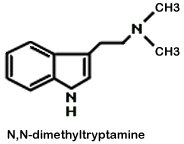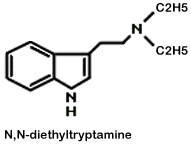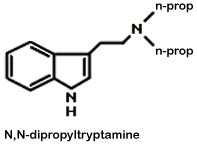DMT
Excerpt from a pharmacology textbook published in 1988Chemical structure and source
This is the prototype member of the tryptamine subclass of indole derivatives. The structural formula is:

The drug is a constituent of many of the same South American snuffs and drinks that contain other psychedelic indole deriviatives, it is often found in the same plants as 5-MeO-DMT, and Indians add a substance containing it to drinks containing harmala alkaloids. DMT is the major constituent of the bark of Virola calophylla, mentioned above; it is also found in the seeds of Anadenanthera peregina; in the seeds of the vine Mimosa hostilis, used in eastern Brazil to make a drink called "ajuca" or "jurema"; in the leaves of Banisteriopsis rusbyana, which are added to the harmaline drinks derived from other plants of the Banisteriopsis genus to make "oco-yage"; and in the leaves of Psychotria viridis, also added to the Banisteriopsis drinks. Like 5-MeO-DMT, DMT must be combined with monoamine oxydase inhibitors to become active orally.
Dose
First strong effects are felt at about 50mg, whether it is smoked or injected. Tolerance develops only after extremely frequent use - injections every two hours for three weeks in rats; at that dose frequency, but not otherwise, there is also a cross-tolerance between DMT and LSD (Rosenberg et. al. 1964; Kovacic and Domino, 1976).Physiological effects
Resembles LSD, but sympathomimetic symptoms like dilated pupils, heightened blood pressure, and increased pulse rate are more common and more intense.Psychological Effects
Like LSD but often more intense. Since it is not taken by mouth, the effects come on suddenly and can be overwhelming. The term "mind blowing" might have been invented for this drug. The experience was described by Alan Watts as like "being fired out of the nozzle of an atomic cannon" (Leary 1968a p.215). Thoughts and visions crowd in at great speed; a sense of leaving or transcending time and a feeling that objects have lost all form and dissolved into a play of vibrations are characteristic. The effect can be like instant transportation to another universe for a timeless sojourn.Duration of action
When DMT is smoked or injected, effects begin in seconds, reach a peak in five to twenty minutes and end after a half hour or so. This has earned it the name "businessman's trip." The brevity of the experience make its intensity bearable, and, for some, desirable.At least two synthetic drugs in which the methyl group of DMT is replaced by a higher radical are psychedelic:


The drug DET is active at the same dose as DMT and the effects last slightly longer, about one and a half to two hours. DPT is longer-acting still and has fewer autonomic side effects. In therapeutic experiments its action continues for one and a half to two hours at the lowest effective dose, 15 to 30mg, and for four to six hours at doses in the range of 60 to 150mg. Both DET and DPT are milder than DMT. The drug 6-FDET (6-fluorodiethyltryptamine) resembles DET in its effects. All these drugs, like DMT, are inactive orally and must be smoked or injected. Dibutyltryptamine (DBT) and higher substitutions are inert, but other synthetic drugs related to DMT may be psychoactive. 7-6-90